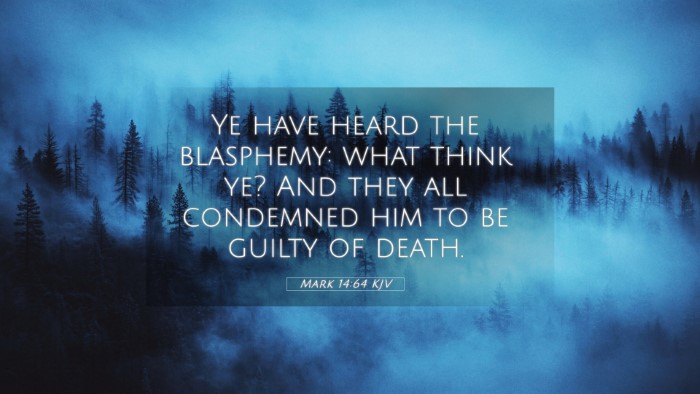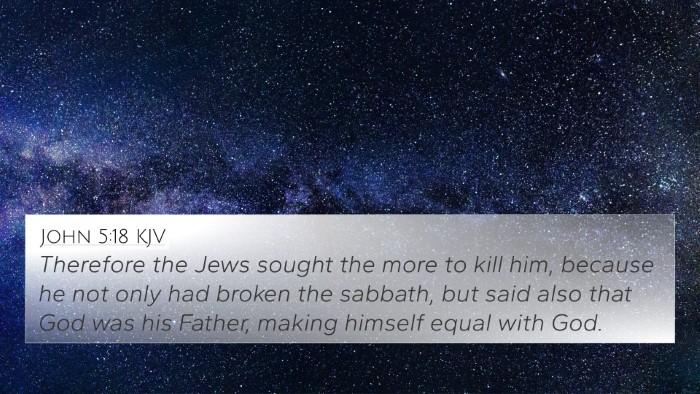Understanding Mark 14:64
Mark 14:64 states: "You have heard the blasphemy. What do you think?" They all condemned him to be guilty of death. This verse occurs during the trial of Jesus before the Sanhedrin, where He is accused of blasphemy for claiming to be the Son of God. Below, we explore various commentaries to gain a deeper understanding of its significance.
Commentary Insights
Matthew Henry's Commentary
Matthew Henry emphasizes the gravity of the accusation against Jesus, highlighting that the Jewish leaders considered His claims as a direct affront to their religious authority. They view His assertion of divinity as a breach of their laws, warranting capital punishment. Henry notes the irony that the very leaders who should recognize the Messiah are the ones condemning Him.
Albert Barnes' Commentary
Albert Barnes focuses on the judicial process depicted in Mark 14:64. He explains that the sentence of death was pronounced in a somewhat informal setting and stresses the wrongful nature of this trial, as it was marked by a lack of due process and fairness. Barnes underscores the importance of the Sanhedrin's verdict as a pivotal moment leading to Jesus' crucifixion.
Adam Clarke's Commentary
Adam Clarke provides insight into the cultural and religious implications of this event. He explains the term "blasphemy," which in Jewish law referred to anyone who would claim divine attributes. Clarke stresses that this reflects the broader rejection of Jesus by the Jewish authorities, setting the stage for His eventual sacrifice for humanity's sins.
Cross-References and Thematic Connections
Understanding Mark 14:64 is enriched through cross-referencing several related Bible verses:
- John 10:33: "The Jews answered Him, 'It is not for a good work that we are going to stone you but for blasphemy, because you, being a man, make yourself God.'"
- Luke 22:71: "And they said, 'What further testimony do we need? We have heard it ourselves from his own lips.'" This illustrates the consensus among the Sanhedrin.
- Matthew 26:65: "Then the high priest tore his robes and said, 'He has uttered blasphemy. What further witnesses do we need?'" This shows the reaction of the high priest.
- Isaiah 53:3: "He was despised and rejected by men; a man of sorrows, and acquainted with grief." This prophecy underscores how Jesus was treated by His own people.
- Acts 7:58: "Then they cast him out of the city and stoned him. And the witnesses laid down their garments at the feet of a young man named Saul." Here, parallels can be drawn in the persecution of believers.
- Romans 8:3: "For God has done what the law, weakened by the flesh, could not do." This reflects on the fulfillment of Jesus' mission despite condemnation.
- Hebrews 13:12: "So Jesus also suffered outside the gate in order to sanctify the people through his own blood." A connection to the implications of His suffering and death.
Thematic Reflections
The themes of injustice and the fulfillment of prophecy are central in Mark 14:64. The accusations against Jesus reveal the tension between divine truth and human error. As believers reflect on this passage, they can consider how it exemplifies the struggles within faith and leadership. Furthermore, the exploration of cross-referencing themes allows for a deeper understanding of the Bible's interconnectedness.
Related Keywords and Concepts
This analysis can be greatly amplified using the following tools for Bible cross-referencing:
- Bible concordance for locating key terms.
- Bible cross-reference guide for thematic studies.
- Cross-reference Bible study to engage in group discussions.
- Identifying connections between Old and New Testament verses to highlight continuity in scripture.
- How to use Bible cross-references effectively in personal studies.
Conclusion
In summary, Mark 14:64 is a profound depiction of Jesus' trial and condemnation. By examining this verse through the insights provided by esteemed commentators and correlating it with other scriptures, believers can engage in a richer, more nuanced understanding. This approach of cross-referencing helps illuminate the intricacies of biblical texts and their interwoven narratives.










